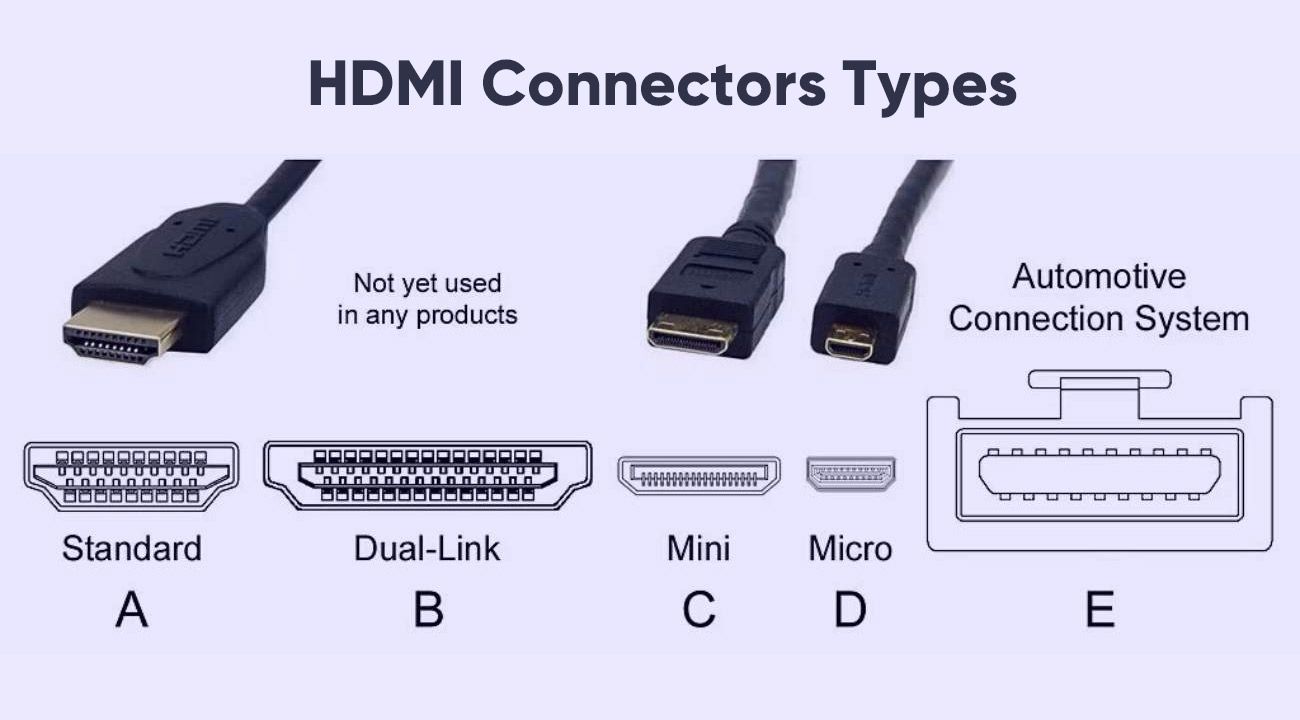HDMI cables are the most important components to connect devices to your home theater or media center setup. All modern laptops, game consoles, monitors, and TVs use HDMI technology. However, not all HDMI cables and connectors are the same across the board.
Primarily, there are 3 types of HDMI cables:
- Standard
- High-speed
- Ultra-high-speed
Each type offers some unique features and variations. Moreover, there are five different kinds of HDMI connectors as well.
Therefore, you will have to understand each of them to find the most suitable HDMI cables and connectors for your system.
In this article, we will explain the different types of HDMI cables and connectors. But before jumping to that, let’s have an overview of HDMI technology and its evolution through history.
What is HDMI?
HDMI, or High-Definition Multimedia Interface, is an audio/video interface standard that transmits digital video and audio from an HDMI-supported source device. It transmits both compressed and uncompressed audio data and uncompressed video simultaneously.
It was developed in 2002 by a group of electronic manufacturers and soon became widely used in most modern display devices such as televisions and computer monitors.
All modern video formats and high-definition signals, including Ultra HD 4K and 8K, are compatible with the HDMI interface. When it comes to audio, HDMI is capable of sending anything from 2-channel PCM stereo audio to 32-channel digital audio formats. DTS-HD Master Audio, Dolby TrueHD, and Dolby Atmos, all require an HDMI interface.
Evolution of HDMI Standards
Through the years since its development, the HDMI standard has passed several evolution stages. With each new version, HDMI technology offered enhanced audio and video output, performance, and additional features. In the table below, you will find a snapshot of the evolution of HDMI standards.
| HDMI Version | Year | Maximum Resolution/ Refresh Rate | Maximum Transmission Rate | HDR | Audio Channel |
| 1.0 | 2002 | 1080p @60 Hz | 4.95 Gbps | No | 8 audio channels |
| 1.1/1.2 | 2005 | 1440p @30 Hz | 4.95 Gbps | No | One-bit audio and DVD audio |
| 1/3/1.4 | 2009 | 4K @60 Hz | 10.2 Gbps | No | Dolby TrueHD, DTS-HD, and ARC |
| 2.0 | 2013 | 5K @30 Hz | 18.0 Gbps | Yes | 32 audio channels, HE-ARC, and DRA |
| 2.1 | 2017 | 8K @30 Hz | 48.0 Gbps | Yes | eARC |
How Many Types Of HDMI Cables Are There?
As we have mentioned, HDMI cables are basically of four types. Some of them come with ethernet as well. Below, we have explained each of these cables so that you can determine which one to pick.

1. Standard HDMI Cable
Standard HDMI cables are ideal for common uses, such as screen projectors, satellite TV, and DVD players. They can transmit videos with high-definition resolution – upto 1080p with a refresh rate of 30Hz. However, you cannot use them to watch 4K or 8K quality videos.
Standard HDMI cables are available with ethernet as well. The ethernet functions as a dedicated data channel. However, to use them, both the connected devices need to have ethernet channels. Furthermore, to connect in-vehicle or portable DVD players and video displays, there are standard automotive cables available. They can transmit string signals even through vibrations.
2. High-Speed HDMI Cable
With high-speed HDMI cables, you can enjoy high resolutions of up to 4K at 30Hz. They also come with display technologies such as deep color and 3D. High-speed HDMI cables are compatible with HDMI versions 1.3 and 1.4 and offer a bandwidth of 10.2 Gbps.
Like standard HDMI cables, high-speed HDMI cables also come with dedicated ethernet channels. However, it is difficult to find devices compatible with such cables. In addition, a version of high-speed HDMI cables is available for use in automobiles. These HDMI cables are capable of withstanding extreme temperatures and vibrations.
3. Ultra High Speed
Whether it is a 4K, 5K, 8K, or 10K video, the ultra high-speed HDMI cables can display anything, mostly at 120Hz. They offer bandwidths of up to 48 Gbps and feature low EMI to reduce interferences with wireless devices. Moreover, they support the newest audio technology – eARC, as well as VRR.
These HDMI cables are compatible with almost all HDMI-enabled devices, even the earlier versions. However, they may be expensive compared to others. You can identify an ultra high-speed HDMI cable by checking its Premium HDMI Cable Certification Label.
Types Of HDMI Cables: Comparison
Now that you understand all the types of HDMI cables out there, let’s put them in one frame and take a quick look at their differences.
| Cable Type | Resolutions | Bandwidths | Best Port |
| Standard | 720p and 1080P @ 60Hz | 4.95 Gbps | <1.4 |
| High-Speed | FHD @ 60Hz, QHD @ 60Hz, and 4K @ 30Hz | 10.2 Gbps | 1.4 |
| Premium High-Speed | 4K @ 60Hz | 18 Gbps | 2.0 |
| Ultra High-Speed | 4K @ 60Hz, 8K @ 120Hz, and 10K @ 120hz | 48 Gbps | 2.1 |
How Many Types Of HDMI Connectors Are There?
HDMI connectors are I/O hardware components, and they work with HDMI cables to transfer data from a suitable AV source to a plugged-in display device.
There are 5 types of HDMI connectors:
- Type-A
- Type-B
- Type-C
- Type-D
- Type-E
Among them, Type-A connectors are the most common, and they were developed with the initial standards. Later, for the specific needs of upgraded HDMI standards, Type-C, Type-D, and Type-E were developed.

HDMI Type-A
HDMI Type-A connectors use a 19-pin configuration. They are also the largest in size, where the male connectors have dimensions of 13.9mm x 4.45mm, and the female connectors have dimensions of 14mm x 4.55mm.
HDMI Type-A connectors are also known as Standard HDMI connectors. As we have already mentioned, Type-A HDMI connectors are the most widely used in devices like conventional TVs, desktop computers, laptops, DVD players, game consoles, video projectors, satellite boxes, recorders, etc.
HDMI Type-B
HDMI Type-B connectors are also known as Extended Pin HDMI connectors. They have a 29-pin configuration for carrying audio and video signals. Moreover, these connectors are larger than Type-A. In general, Type-B connectors are 21.2mm x 4.45mm in dimensions.
Type-B connectors were developed for very high-resolution displays, but now they are not as common as they were before. They also feature dual-link, which became obsolete after the development of HDMI 1.3, making single-link more mainstream.
HDMI Type-C
HDMI Type-C connectors are called Mini HDMI connectors. They have a 19-pin configuration, and they are commonly used for small devices like tablets, recorders, DSLR cameras, sat nav systems, etc. In short, they do everything Type-A connectors do, but in a smaller context. Type-C connectors usually have dimensions of 10.42mm x 2.42mm, and they were developed for HDMI version 1.3.
HDMI Type-D
HDMI Type-D connectors are referred to as Micro HDMI connectors. They are similar to Type-C connectors and also have a 19-pin configuration. However, with dimensions of 6.4mm x 2.8mm, they are much smaller than Type-C. Type-D connectors were developed for HDMI version 1.4. They are commonly found on small portable devices like smartphones, small cameras, etc.
HDMI Type-E
HDMI Type-E connectors were introduced with HDMI version 1.4, and they are particularly designed for automotive applications. Each Type-E connector comes with a locking tab and a shell. Therefore, it can withstand vibrations and protect itself from dirt and moisture.
Tips for Buying the Right Type of HDMI Cables
Now that you are familiar with the different types of HDMI cables and connectors, you can pick the ones that are the most compatible with your devices. However, before buying an HDMI cable, keep the following tips in mind.
- Determine the length you will need beforehand. If the cables are too long, it will clutter your space and will not fit into your setup properly. In contrast, if the cables are too short, it won’t be able to connect the devices as you want. That’s why identify the required length before shopping for HDMI cables.
- Check the connector type carefully and identify it clearly before looking for a compatible HDMI cable.
- Check for the cable’s official certification logo to ensure its authenticity and performance.
- Avoid buying overpriced or suspiciously inexpensive HDMI cables. Very expensive HDMI cables hardly add significant value, but cheap cables usually have quality and performance issues.







